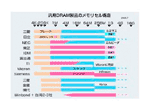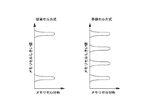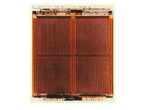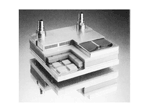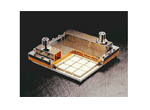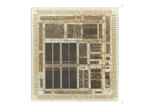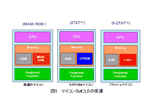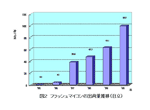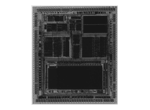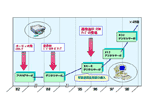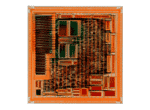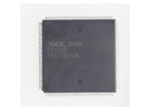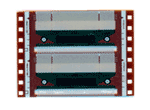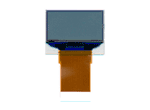Integrated Circuits
1990s
Decade of system LSIs (SoC)In the DRAM area, although Japanese companies continued to increase memory capacities, they were caught on the back foot in terms of business by the rise of South Korean companies.At the same time, new types of flash memory appeared and the market for these products started to expand.
For microprocessors, development policies shifted from the second-source production of processors based on Intel's or Motorola's models to the creation of original processors, and 32-bit original microprocessors appeared. With the increasing numbers of elements integrated on each chip, implementing a large portion of system functions on a chip became possible, and the system LSI (SoC: system-on-a-chip) age began.
In the late 1990s, separation between fabless semiconductor companies (design companies) and foundry companies (fabrication companies) started in the logic product field. As larger-scale system functions were integrated on LSI chips and design capabilities gained importance, U.S. leadership in design technology and EDA tool ability created a widening gap.
1990s: Larger and faster DRAM; radical change in the DRAM business
DRAM capacities continued to increase in the 1990s; full-scale mass-production of 4-Mbit and 16-Mbit DRAM was followed by the development of 64-Mbit, 128-Mbit, 256-Mbit, and 512-Mbit products, and then 1-Gbit DRAM.
Data transfer rates also accelerated, with fast page mode DRAM and EDO (extended data out) DRAM being replaced by synchronous DRAM, followed by the development of DDR (double data rate) DRAM. The position of Japan manufacturers declined as South Korean companies increased their share.
1990s: Multi-level and larger-capacity flash memory
Progress in flash memory can be largely divided into two types: the NOR type and the NAND type. The development of flash memory in the 1990s started with 1-Mbit devices and proceeded up to 256-Mbit devices. NAND-type flash memory moved ahead of NOR-type in terms of increasing capacity.
Multi-level technology, allowing the writing of two-bit data to each single cell, was also invented. Flash memory devices using this technology were presented at academic conferences, for NOR flash memory in 1995 (Intel) and 1996 (NEC: 64 Mbits) and for NAND flash memory in 1995 (Toshiba) and 1996 (Samsung: 128 Mbits).
1990s: Evolution of SoCs
As ASIC devices began to incorporate larger-scale system functions, these came to include the CPU core and bus architecture. With advances in EDA tools, configuring a system as an LSI circuit by combining basic unit functions became possible, with each unit function representing a form of intellectual property (IP). This type of LSI is called the SoC (system-on-a-chip).
In SoC development, the relative importance of the base design (preparation of IPs for the required functions and a library for the target process) preceding the specific chip design increased.
1990s: Shift of mainframe CPUs to CMOS
ECL bipolar technology had been long used for the ultrafast devices for mainframe computers. As semiconductor technology progressed, though, mainframe computers using the most advanced CMOS technology were produced for the high-end market.
The performance of CMOS machines was initially inferior, but it surpassed that of bipolar machines as CMOS technology was improved over the next three to four years, and CMOS mainframes became the main stream since the year 2000.
1992: 32-bit RISC microprocessors/controllers with original architecture (Hitachi)
With the start of the multimedia age, the development of 32-bit microprocessors began. The policy for original-architecture was reinforced in the development strategy of 32-bit microprocessors. In 1992, Hitachi released the SH microprocessor/controller, which had an original 32-bit RISC architecture.
1993: Microcontroller with on-chip flash memory (Hitachi)
In 1993, Hitachi developed a 16-bit microcontroller with on-chip flash memory, the H8-538F, and began selling it in the industrial and office automation markets.
In contrast to a conventional microcontrollers with mask-programmed ROM or EPROM (ZTAT microprocessor), this new microcontroller was programmable in the field.
This provided significant advantages to the users, and led to a rapidly expanding market for microcontrollers with on-chip flash memory, which became the mainstream technology for microcontrollers.
Early 1990s: Evolution of digital servo LSI circuit for CD/CDROM
Digital servo LSI circuits were under active development. In 1992, Panasonic Corporation (formerly Matsushita Electronic Works Co., Ltd.) developed an LSI circuit for CD players that incorporated an optical servo, D/A converter, and signal processing circuits on a single chip. In 1994, Toshiba started to release two commercial digital servo chip-set series, CD-X and CD-EX. These digital servo devices allowed the modification of servo characteristics as desired through digital coefficients and eased increases to the speed factor for CDROMs, which ultimately reached x52 speed.
1997: Single-chip MPEG2 encoder (NEC)
In 1997, NEC successfully developed the world’s first single-chip MPEG2 (Moving Picture Experts Group 2) encoder LSI circuit after developing an original motion detection circuit and an optimal algorithm for reducing the circuit scale as well as an algorithm for encoding high-quality images at a low bit rate. This LSI circuit was incorporated into consumer DVD recorders, which were released in 1999 and have increased in popularity since then.
Late 1990s: Progress in liquid crystal display (LCD) drivers
LCDs were initially used in watches and calculators in the 1970s, then expanded its applications to laptop computers and monitors in the 1990s.
The use of TFT LCDs in personal computers increased through the late 1990s.
The market for LCDs for mobile phones also greatly expanded by the end of the decade. Consequently, marked progress was made in LCD drivers products. This progress in LCDs during the 1990s was expedited by development of the tape carrier package (TCP) mounting technology, improvements in breakdown voltage, microfabrication of the process size, and the implementation of color display functions.


